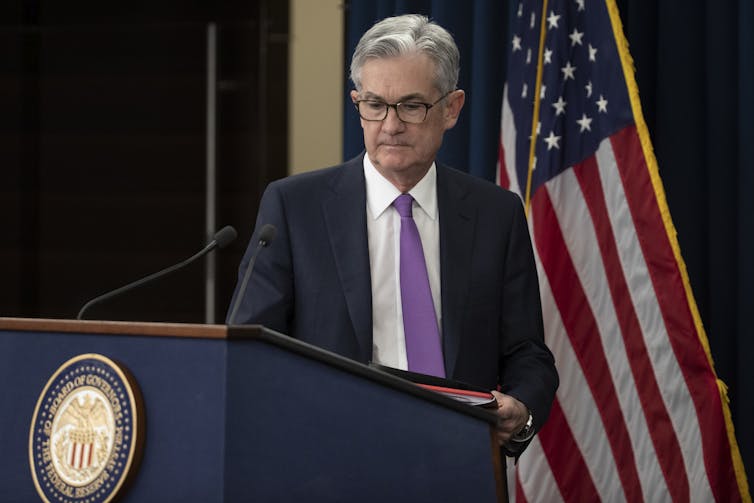
Federal Reserve Chairman Jerome Powell speaks at a news conference. AP Photo/Alex Brandon
By Thomas Gilbert | January 31, 2019
The Federal Reserve policy equivalent of a sharp 90-degree turn.
On Jan. 30, the U.S. central bank signaled that it was done raising benchmark interest rates after two years of aggressive rate hikes. As such, the Fed held its target rate steady at a range of 2.25 percent to 2.5 percent.
This stands in sharp contrast to six weeks ago, when the Fed was forecasting two hikes in 2019 and at least one more in 2020.
The abrupt change was maybe not a complete surprise given the market jitters in December following its last decision to raise interest rates. Back then, investors reacted negatively to the prospect of further rate increases slowing the U.S. economy, which has been performing well. Today, there are growing concerns about slowing growth abroad, which increases the risk of a domestic slowdown.
In my view as a scholar who studies how financial news affects markets, the Fed’s decision to keep rates where they are is a way for it to signal its awareness of significant and increasing risks on the horizon. By declaring that it “will be patient,” the central bank is giving itself plenty of room to maneuver if things get worse.
US economy going strong
The Fed’s two main goals are maximum employment and price stability. And by both measures, conditions in the U.S. are about as good as you can get.
Jobs growth continues to be strong, with companies adding 312,000 jobs in December. Wages are rising and the unemployment rate has hovered below 4 percent since July. In September, it reached a 49-year low.
Inflation, meanwhile, was 1.9 percent at the end of 2018, close to the Fed’s target of 2 percent.
More than that, the U.S. economy has been on a tear for much of the past year and a half, posting some of the strongest growth figures in five years.
Global headwinds and the shutdown
Unfortunately, that’s not the end of the story. In his press conference after the decision, Fed Chairman Jerome Powell pointed to several increased risks and headwinds that could throw sand in the well-oiled U.S. economic machine.
For one thing, we still don’t know the full impact of the 35-day partial government shutdown, but it will for sure lead to lower first-quarter GDP growth. The Congressional Budget Office estimates the cost of the shutdown at US$11 billion, which will be offset in coming quarters by about $8 billion of increased activity as a result of starting the government back up. It is also unclear if lawmakers and the president will reach a deal before the three-week truce is up in February.
In addition, surveys of consumer and business confidence have been edging lower. The risk of disruption to the global supply chain from tariffs, trade wars and Brexit as well as slower growth in major economies like China and the European Union remains high.
Growing risks
Taken together, these seemingly contrarian numbers – solid domestically but weak internationally – have led the Fed to dramatically change its stance on the path of interest rates.
One way to interpret this abrupt change is that, while the Fed continues to believe that GDP will grow by more than 2 percent in 2019, the risks have clearly increased.
Is this to say that the Fed views a recession as more likely? Perhaps. But by keeping interest rates steady, the central bank is giving the economy as much breathing room as possible, allowing businesses and consumers to access capital at lower borrowing costs. Moreover, it is quite likely that no rate increases will be considered until spring at the earliest.
That doesn’t mean it is time to start stocking up on canned goods. But the latest Fed move does suggest that the end of the current economic expansion – which will soon be the longest on record – may be closer than previously thought.![]()
Thomas Gilbert, Associate Professor of Finance and Business Economics, University of Washington
This article is republished from The Conversation under a Creative Commons license. Read the original article.
